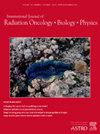基于保留卵巢的宫颈癌患者多指标模型研究的个体化放疗方案
IF 6.4
1区 医学
Q1 ONCOLOGY
International Journal of Radiation Oncology Biology Physics
Pub Date : 2024-10-01
DOI:10.1016/j.ijrobp.2024.07.020
引用次数: 0
摘要
目的对于先行保留卵巢根治术再行放疗的宫颈癌患者,由于保留卵巢治疗方案的野角限制,极易出现骨髓抑制。因此,物理师需要提前评估患者的综合情况,权衡利弊,为这类患者制定临床治疗方案。材料/方法首先,我们追踪了2022年至2024年在我院接受保留卵巢根治术的75例宫颈癌患者的放疗过程。通过生物信息学分析,我们确定了这些患者中与骨髓抑制相关的基因。然后,使用三维切片机软件处理患者的 CT 图像数据,并通过 R 软件中的 DVHmetrics 软件包计算物理剂量信息。结合患者临床特征,通过机器学习方法(T检验、LASSO、随机森林、XGboost等)筛选出与DVH剂量、CT成像和基因相关的多omics模型特征。结果基因组学显示,HnRNPA1与保卵巢患者的骨髓抑制呈负相关,hnRNPA1低表达的患者比高表达的患者更容易出现骨髓抑制。卵巢体积、卵巢到皮肤表面的距离、卵巢到PTV的距离、患者肚脐切片处的腹围、盆腔V70等5个剂量组学特征与骨髓抑制呈正相关。而 7 个成像全息特征与骨髓抑制呈正相关,包括诊断_假体插值_最小值、原始_形状_主轴长度等。通过机器学习建立了基于基因组学、剂量组学和放射组学的相关性评分,该评分在预测放疗后骨髓抑制方面的AUC超过了0.67。我们的研究以接受保留卵巢根治术的宫颈癌患者为研究对象,通过多omics模式分析(基因组学+体细胞学+放射组学),确定了相关特征,并明确了这些特征与临床治疗评分策略的关系,以快速评估骨髓抑制的可能性。该评分同时考虑了物理意义和生物学意义,可为物理学家提供更好的个体化临床卵巢保留放疗方案提供参考。本文章由计算机程序翻译,如有差异,请以英文原文为准。
Individual Radiotherapy Plan Based on Multi-Omics Model Study for Cervical Cancer Patients with Ovarian Preservation
Purpose/Objective(s)
For cervical cancer patients who underwent ovarian preservation radical surgery before radiotherapy, bone marrow suppression occurred with a high probability due to the limitation of the fields angle with the ovarian preservation treatment plan. Therefore, physicists need to evaluate the patient’s comprehensive condition in advance to weigh the advantages and disadvantages to make a clinical treatment plan for these patients.
Materials/Methods
Firstly, we tracked the radiotherapy process of 75 cervical cancer patients who underwent ovarian preservation radical surgery in our hospital from 2022 to 2024. Through bioinformatics analysis, we identified genes related to bone marrow suppression in these patients. Then, 3D-slicer software was used to process CT image data of patients, and physical dose information was calculated through DVHmetrics package from R software. Combined with patient clinical characteristics, multi omics model features were screened related to DVH dose, CT imaging, and genes by machine learning methods (T-test, LASSO, random forest, XGboost, etc.). Finally, these parameters were integrated and scored, and a nomograph was created, which may play an important role in selecting optimal plan for physicist.
Results
Genomics revealed a negative correlation between HnRNPA1 and bone marrow suppression in ovarian conserving patients, patients with low expression of hnRNPA1 were more prone to bone marrow suppression than those with high expression. Five dosomics features were positively correlated with bone marrow suppression, including ovarian volume, distance from ovary to skin surface, distance from ovary to PTV, abdominal circumference of patients at the navel slice, pelvic V70. And 7 imaging omics features were positively correlated with bone marrow suppression, including diagnostics_Mask-interpolated_Minimum, original_shape_MajorAxisLength, etc. A correlation score based on genomics, dosomics, and radiomics was established through machine learning, which achieved an AUC of over 0.67 in predicting bone marrow suppression after radiotherapy.
Conclusion
Our research focused on cervical cancer patients who underwent ovarian preservation radical surgery. Through multi omics mode analysis (genomics+dosomics+radiomics), relevant features were identified, and their relationships were clarified with clinical treatment scoring strategy for rapid evaluating bone marrow suppression possibility. Both physical and biological significance were considered from this score, which can serve as a reference for physicists to provide better individual clinical ovarian conserving radiotherapy plans.
求助全文
通过发布文献求助,成功后即可免费获取论文全文。
去求助
来源期刊
CiteScore
11.00
自引率
7.10%
发文量
2538
审稿时长
6.6 weeks
期刊介绍:
International Journal of Radiation Oncology • Biology • Physics (IJROBP), known in the field as the Red Journal, publishes original laboratory and clinical investigations related to radiation oncology, radiation biology, medical physics, and both education and health policy as it relates to the field.
This journal has a particular interest in original contributions of the following types: prospective clinical trials, outcomes research, and large database interrogation. In addition, it seeks reports of high-impact innovations in single or combined modality treatment, tumor sensitization, normal tissue protection (including both precision avoidance and pharmacologic means), brachytherapy, particle irradiation, and cancer imaging. Technical advances related to dosimetry and conformal radiation treatment planning are of interest, as are basic science studies investigating tumor physiology and the molecular biology underlying cancer and normal tissue radiation response.

 求助内容:
求助内容: 应助结果提醒方式:
应助结果提醒方式:


